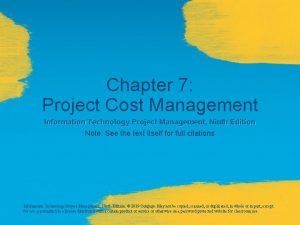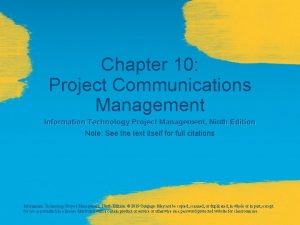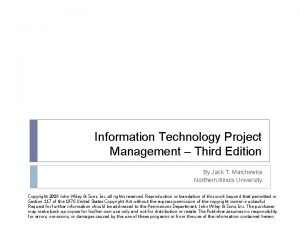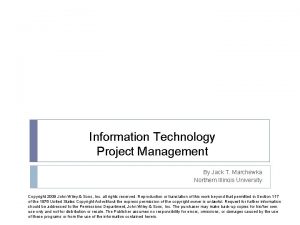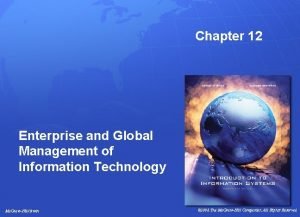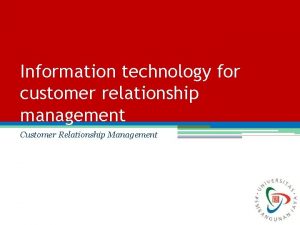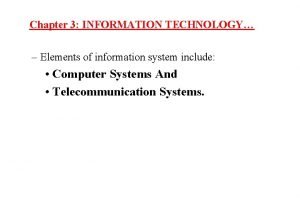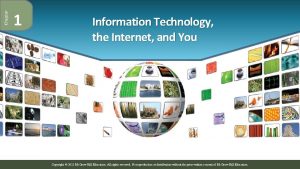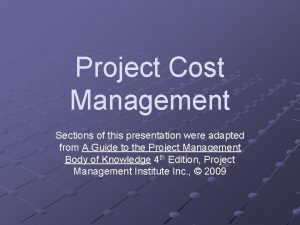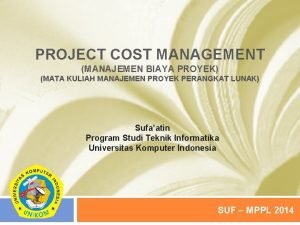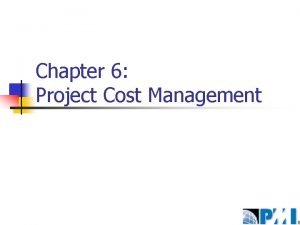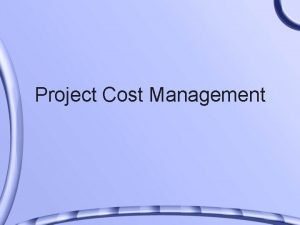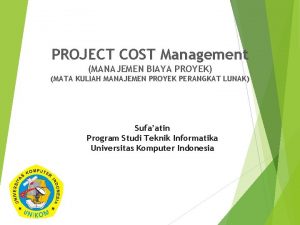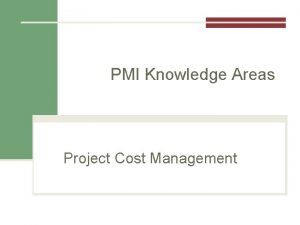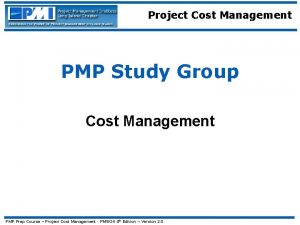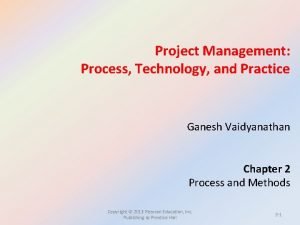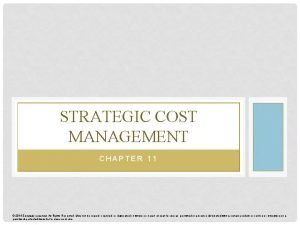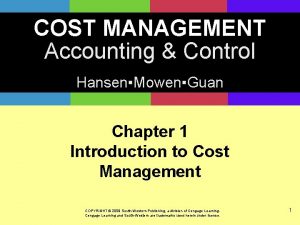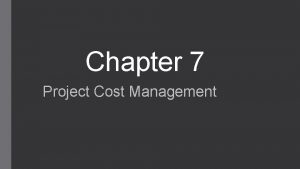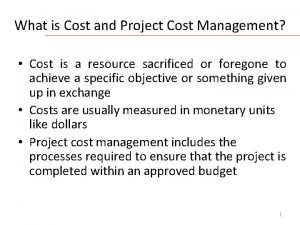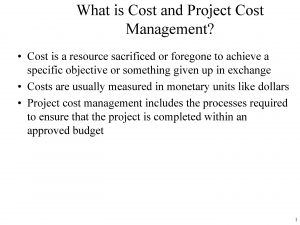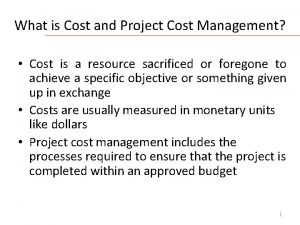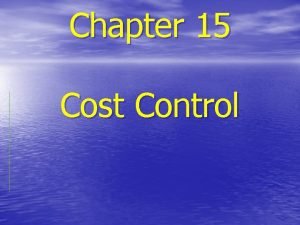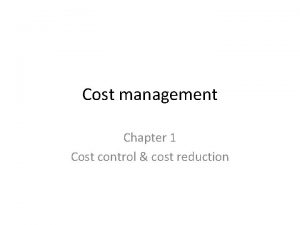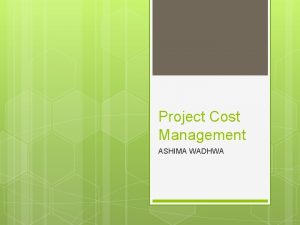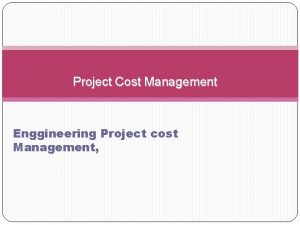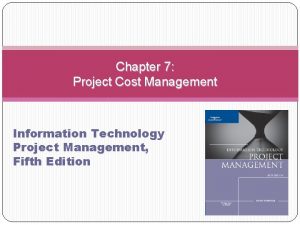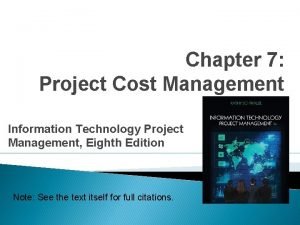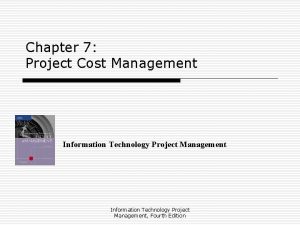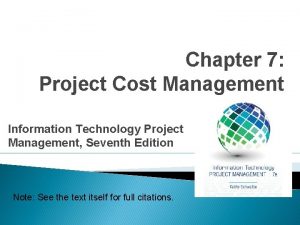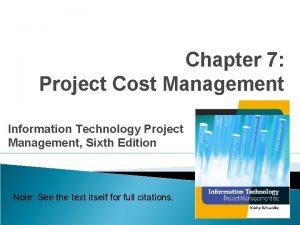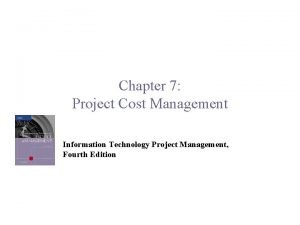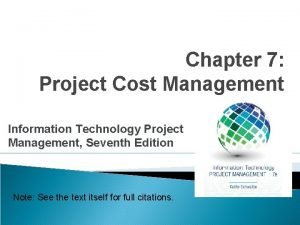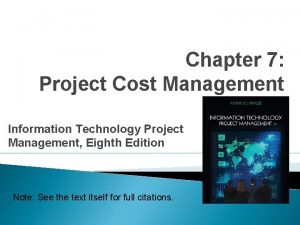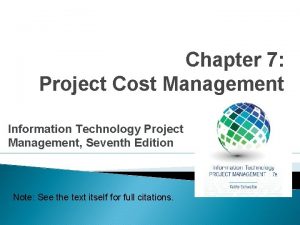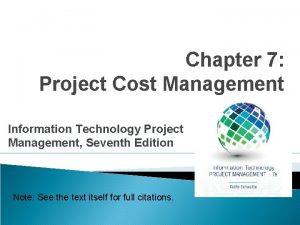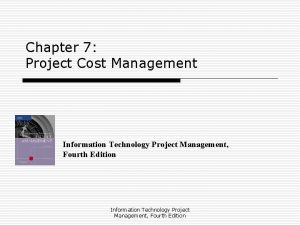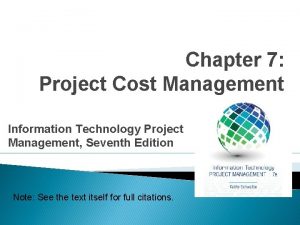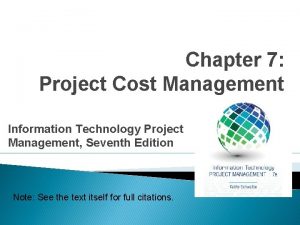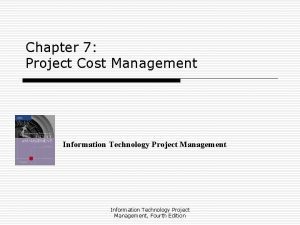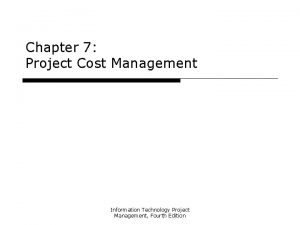Chapter 7 Project Cost Management Information Technology Project








































- Slides: 40

Chapter 7: Project Cost Management Information Technology Project Management, Ninth Edition Note: See the text itself for full citations Information Technology Project Management, Ninth Edition. © 2019 Cengage. May not be copied, scanned, or duplicated, in whole or in part, except for use as permitted in a license distributed with a certain product or service or otherwise on a password-protected website for classroom use.

Learning Objectives (1 of 2) • Develop a justification for project cost management and its importance in achieving project success • Explain basic project cost management principles, concepts, and terms • Describe the process of planning cost management • Discuss different types of cost estimates and methods for preparing them • Using an example of an information technology (IT) project, list and describe the processes of determining a budget and preparing a cost estimate Information Technology Project Management, Ninth Edition. © 2019 Cengage. May not be copied, scanned, or duplicated, in whole or in part, except for use as permitted in a license distributed with a certain product or service or otherwise on a password-protected website for classroom use.

Learning Objectives (2 of 2) • Justify the use of earned value management and project portfolio management to assist in cost control • Describe how project management software can assist in project cost management • Discuss considerations for agile/adaptive environments Information Technology Project Management, Ninth Edition. © 2019 Cengage. May not be copied, scanned, or duplicated, in whole or in part, except for use as permitted in a license distributed with a certain product or service or otherwise on a password-protected website for classroom use.

The Importance of Project Cost Management • IT projects have a poor track record for meeting budget goals • Cost overrun is the additional percentage or dollar amount by which actual costs exceed estimates • A 2011 Harvard Business Review study reported an average cost overrun of 27 percent • Most important finding was the discovery of a large number of gigantic overages or “black swans”; a high-impact event that is rare and unpredictable, but not improbable in retrospect Information Technology Project Management, Ninth Edition. © 2019 Cengage. May not be copied, scanned, or duplicated, in whole or in part, except for use as permitted in a license distributed with a certain product or service or otherwise on a password-protected website for classroom use.

What Went Wrong? • The United Kingdom’s National Health Service IT modernization program was called the greatest IT disaster in history with an estimated $26 billion overrun • Program had problems due to incompatible systems, resistance from physicians, and arguments among contractors about who’s responsible for what • Scrapped in 2011 Information Technology Project Management, Ninth Edition. © 2019 Cengage. May not be copied, scanned, or duplicated, in whole or in part, except for use as permitted in a license distributed with a certain product or service or otherwise on a password-protected website for classroom use.

What is Cost? • Cost is a resource sacrificed or foregone to achieve a specific objective or something given up in exchange • Usually measured in monetary units like dollars that must be paid to acquire goods and services Information Technology Project Management, Ninth Edition. © 2019 Cengage. May not be copied, scanned, or duplicated, in whole or in part, except for use as permitted in a license distributed with a certain product or service or otherwise on a password-protected website for classroom use.

What is Project Cost Management? (1 of 2) • Project cost management includes the processes required to ensure that the project is completed within an approved budget • Planning cost management: determining the policies, procedures, and documentation that will be used for planning, executing, and controlling project cost • Estimating costs: developing an approximation or estimate of the costs of the resources needed to complete a project • Determining the budget: allocating the overall cost estimate to individual work items to establish a baseline for measuring performance • Controlling costs: controlling changes to the project budget Information Technology Project Management, Ninth Edition. © 2019 Cengage. May not be copied, scanned, or duplicated, in whole or in part, except for use as permitted in a license distributed with a certain product or service or otherwise on a password-protected website for classroom use.

What is Project Cost Management? (2 of 2) Information Technology Project Management, Ninth Edition. © 2019 Cengage. May not be copied, scanned, or duplicated, in whole or in part, except for use as permitted in a license distributed with a certain product or service or otherwise on a password-protected website for classroom use.

Basic Principles of Cost Management (1 of 3) • Most members of an executive board better understand are more interested in financial terms than IT terms; they need to be able to present and discuss project information in both • Profits: revenues minus expenditures • Profit margin: ratio of profits to revenues • Life cycle costing: considers total cost of ownership, or development plus support costs, for a project • Cash flow analysis: determines estimated annual costs and benefits for a project and resulting annual cash flow Information Technology Project Management, Ninth Edition. © 2019 Cengage. May not be copied, scanned, or duplicated, in whole or in part, except for use as permitted in a license distributed with a certain product or service or otherwise on a password-protected website for classroom use.

Media Snapshot • You cannot measure ROI unless you have a benefits measurement process in place • 2015 report by PMI findings • Many organizations do not have a benefits measurement process • 20 percent of organizations report having a high level of benefits realization maturity • 39 percent of high-performing organizations report high benefits realization maturity compared to nine percent of low performers Information Technology Project Management, Ninth Edition. © 2019 Cengage. May not be copied, scanned, or duplicated, in whole or in part, except for use as permitted in a license distributed with a certain product or service or otherwise on a password-protected website for classroom use.

What Went Right? • Investing in green IT and other initiatives has helped both the environment and companies’ bottom lines • Michael Dell, CEO of Dell, reached his goal to make his company “carbon neutral” in 2008 • As of March 2012, Dell had helped its customers save almost $7 billion in energy costs • In 2014 Dell reported being on track toward reaching their goal of recovering two billion pounds of used electronics by 2020 Information Technology Project Management, Ninth Edition. © 2019 Cengage. May not be copied, scanned, or duplicated, in whole or in part, except for use as permitted in a license distributed with a certain product or service or otherwise on a password-protected website for classroom use.

Basic Principles of Cost Management (2 of 3) • Types of costs and benefits • Tangible costs or benefits are those costs or benefits that an organization can easily measure in dollars • Intangible costs or benefits are costs or benefits that are difficult to measure in monetary terms • Direct costs are costs that can be directly related to producing the products and services of the project • Indirect costs are costs that are not directly related to the products or services of the project, but are indirectly related to performing the project • Sunk cost is money that has been spent in the past; when deciding what projects to invest in or continue, you should not include sunk costs Information Technology Project Management, Ninth Edition. © 2019 Cengage. May not be copied, scanned, or duplicated, in whole or in part, except for use as permitted in a license distributed with a certain product or service or otherwise on a password-protected website for classroom use.

Basic Principles of Cost Management (3 of 3) • Additional concepts • Learning curve theory states that when many items are produced repetitively, the unit cost of those items decreases in a regular pattern as more units are produced • Reserves are dollars included in a cost estimate to mitigate cost risk by allowing for future situations that are difficult to predict • Contingency reserves allow for future situations that may be partially planned for (sometimes called known unknowns) and are included in the project cost baseline • Management reserves allow for future situations that are unpredictable (sometimes called unknowns) Information Technology Project Management, Ninth Edition. © 2019 Cengage. May not be copied, scanned, or duplicated, in whole or in part, except for use as permitted in a license distributed with a certain product or service or otherwise on a password-protected website for classroom use.

Advice for Young Professionals • If you have never done so, take a class or do self-study in accounting, financial statements, or financial management • There are many online resources and short books available on the topics of finance for the non-financial manager, how to use financial statements, or similar content • Financial specialists are often willing to help less-experienced people better understand the key terminology of the financial field Information Technology Project Management, Ninth Edition. © 2019 Cengage. May not be copied, scanned, or duplicated, in whole or in part, except for use as permitted in a license distributed with a certain product or service or otherwise on a password-protected website for classroom use.

Planning Cost Management • The first step in project cost management is planning how the costs will be managed throughout the life of the project • The project team uses expert judgment, analytical techniques, and meetings to develop the cost management plan • Cost management plan includes: • • Level of accuracy Units of measure Organizational procedure links Control thresholds Rules of performance measurement Reporting formats Process descriptions Information Technology Project Management, Ninth Edition. © 2019 Cengage. May not be copied, scanned, or duplicated, in whole or in part, except for use as permitted in a license distributed with a certain product or service or otherwise on a password-protected website for classroom use.

Estimating Costs (1 of 4) • Project managers must take cost estimates seriously if they want to complete projects within budget constraints • Types of cost estimates • Tools and techniques for estimating costs • Typical problems associated with IT cost estimates Information Technology Project Management, Ninth Edition. © 2019 Cengage. May not be copied, scanned, or duplicated, in whole or in part, except for use as permitted in a license distributed with a certain product or service or otherwise on a password-protected website for classroom use.

Estimating Costs (2 of 4) Type of Estimate When Done Why Done Typical Range Rough order of magnitude (ROM) Very early in the project life cycle, often 3– 5 years before project completion Provides estimate of cost for selection decisions -50% to + 100% Budgetary Early, 1– 2 years out Puts dollars in the budget plans -10% to +25% Definitive Later in the project, less than 1 year out Puts dollars in the budget plans -5% to +10% Table 7 -1 Types of cost estimates Information Technology Project Management, Ninth Edition. © 2019 Cengage. May not be copied, scanned, or duplicated, in whole or in part, except for use as permitted in a license distributed with a certain product or service or otherwise on a password-protected website for classroom use.

Estimating Costs (3 of 4) • The number and type of cost estimates vary by application area • The Association for the Advancement of Cost Engineering International identifies five types of cost estimates for construction projects • Order of magnitude, conceptual, preliminary, definitive, and control • Estimates are usually done at various stages of a project • Should become more accurate as time progresses • It is important to provide supporting details for estimates and updates to project documents • A large percentage of total project costs are often labor costs Information Technology Project Management, Ninth Edition. © 2019 Cengage. May not be copied, scanned, or duplicated, in whole or in part, except for use as permitted in a license distributed with a certain product or service or otherwise on a password-protected website for classroom use.

Estimating Costs (4 of 4) Department Year 1 Year 2 Year 3 Year 4 Year 5 Totals Information systems 24 31 35 13 13 116 Marketing systems 3 3 3 15 Reservations 12 29 33 9 7 90 Contractors 2 3 1 0 0 6 Totals 41 66 72 25 23 227 Table 7 -2 Maximum FTE by department by year Information Technology Project Management, Ninth Edition. © 2019 Cengage. May not be copied, scanned, or duplicated, in whole or in part, except for use as permitted in a license distributed with a certain product or service or otherwise on a password-protected website for classroom use.

Cost Estimation Tools and Techniques • Analogous or top-down estimates • Use the actual cost of a previous, similar project as the basis for estimating the cost of the current project • Bottom-up estimates • Involve estimating individual work items or activities and summing them to get a project total • Three-point estimates • Involve estimating the most likely, optimistic, and pessimistic costs for items • Parametric estimating • Uses project characteristics (parameters) in a mathematical model to estimate project costs Information Technology Project Management, Ninth Edition. © 2019 Cengage. May not be copied, scanned, or duplicated, in whole or in part, except for use as permitted in a license distributed with a certain product or service or otherwise on a password-protected website for classroom use.

Typical Problems with IT Cost Estimates • Reasons for inaccuracies • • Estimates are done too quickly People lack estimating experience Human beings are biased toward underestimation Management desires accuracy Information Technology Project Management, Ninth Edition. © 2019 Cengage. May not be copied, scanned, or duplicated, in whole or in part, except for use as permitted in a license distributed with a certain product or service or otherwise on a password-protected website for classroom use.

How to Develop a Cost Estimate and Basis of Estimates (1 of 3) • See the text for a detailed example of creating a cost estimate for the Surveyor Pro project described in the opening case • Before creating an estimate gather as much information as possible about the project, ask how the organization plans to use the cost estimate, and clarify the ground rules and assumptions Information Technology Project Management, Ninth Edition. © 2019 Cengage. May not be copied, scanned, or duplicated, in whole or in part, except for use as permitted in a license distributed with a certain product or service or otherwise on a password-protected website for classroom use.

How to Develop a Cost Estimate and Basis of Estimates (2 of 3) Information Technology Project Management, Ninth Edition. © 2019 Cengage. May not be copied, scanned, or duplicated, in whole or in part, except for use as permitted in a license distributed with a certain product or service or otherwise on a password-protected website for classroom use.

How to Develop a Cost Estimate and Basis of Estimates (3 of 3) Information Technology Project Management, Ninth Edition. © 2019 Cengage. May not be copied, scanned, or duplicated, in whole or in part, except for use as permitted in a license distributed with a certain product or service or otherwise on a password-protected website for classroom use.

Best Practice • Alvin Alexander wrote a book called Cost Estimating in an Agile Development Environment in 2015 • Function points are a means of measuring software size in terms that are meaningful to end users • User stories are a common way to describe requirements in a simple, concise way • Developers can analyze user stories to estimate the number of internal logical files (ILFs)—a group of logically related data that resides entirely within the application boundary and is maintained through external inputs Information Technology Project Management, Ninth Edition. © 2019 Cengage. May not be copied, scanned, or duplicated, in whole or in part, except for use as permitted in a license distributed with a certain product or service or otherwise on a password-protected website for classroom use.

Determining the Budget (1 of 2) • Budgeting involves allocating the project cost estimate to individual work items over time • Material resources or work items are based on the activities in the WBS for the project • Important goal is to produce a cost baseline • Time-phased budget that project managers use to measure and monitor cost performance Information Technology Project Management, Ninth Edition. © 2019 Cengage. May not be copied, scanned, or duplicated, in whole or in part, except for use as permitted in a license distributed with a certain product or service or otherwise on a password-protected website for classroom use.

Determining the Budget (2 of 2) Information Technology Project Management, Ninth Edition. © 2019 Cengage. May not be copied, scanned, or duplicated, in whole or in part, except for use as permitted in a license distributed with a certain product or service or otherwise on a password-protected website for classroom use.

Controlling Costs • Activities involved in controlling project costs • Monitoring cost performance • Ensuring that only appropriate project changes are included in a revised cost baseline • Informing project stakeholders of authorized changes to the project that will affect costs • Several tools and techniques assist in project cost control • Expert judgment, data analysis, project management information systems, and the to-complete performance index Information Technology Project Management, Ninth Edition. © 2019 Cengage. May not be copied, scanned, or duplicated, in whole or in part, except for use as permitted in a license distributed with a certain product or service or otherwise on a password-protected website for classroom use.

Earned Value Management (EVM) (1 of 5) • Project performance measurement technique that integrates scope, time, and cost data • Given a baseline (original plan plus approved changes), you can determine how well the project is meeting scope, time, and cost goals • Earned value management involves calculating three values for each activity or summary activity from a project’s WBS • Planned value • Actual cost • Earned value Information Technology Project Management, Ninth Edition. © 2019 Cengage. May not be copied, scanned, or duplicated, in whole or in part, except for use as permitted in a license distributed with a certain product or service or otherwise on a password-protected website for classroom use.

Earned Value Management (EVM) (2 of 5) Activity Week 1 Earned value (EV) 5, 000 Planned value (PV) 10, 000 Actual cost (AC) 15, 000 Cost variance (CV) -10, 000 Schedule variance (SV) -5, 000 Cost performance index (CPI) 33% Schedule performance index (SPI) 50% Table 7 -3 Earned value calculations for one activity after week 1 Information Technology Project Management, Ninth Edition. © 2019 Cengage. May not be copied, scanned, or duplicated, in whole or in part, except for use as permitted in a license distributed with a certain product or service or otherwise on a password-protected website for classroom use.

Earned Value Management (EVM) (3 of 5) Term Formula Earned value (EV) EV = PV of all completed work Cost variance (CV) CV = EV - AC Schedule variance (SV) SV = EV - PV Cost performance index (CPI) CPI = EV/AC Schedule performance index (SPI) SPI = EV/PV Estimate at completion (EAC) EAC = BAC/CPI Estimated to Complete (ETC) ETC = EAC - AC Table 7 -4 Earned value formulas Information Technology Project Management, Ninth Edition. © 2019 Cengage. May not be copied, scanned, or duplicated, in whole or in part, except for use as permitted in a license distributed with a certain product or service or otherwise on a password-protected website for classroom use.

Earned Value Management (EVM) (4 of 5) • Important concepts • • Cost variance (CV) is the earned value minus the actual cost Schedule variance (SV) is the earned value minus the planned value Cost performance index (CPI) is the ratio of earned value to actual cost Schedule performance index (SPI) is the ratio of earned value to planned value • Estimate at completion (EAC) is an estimated cost of completing a project based on performance to date • To-complete performance index (TCPI) is a measure of the cost performance that must be achieved with the remaining resources to meet a specific goal Information Technology Project Management, Ninth Edition. © 2019 Cengage. May not be copied, scanned, or duplicated, in whole or in part, except for use as permitted in a license distributed with a certain product or service or otherwise on a password-protected website for classroom use.

Earned Value Management (EVM) (5 of 5) Information Technology Project Management, Ninth Edition. © 2019 Cengage. May not be copied, scanned, or duplicated, in whole or in part, except for use as permitted in a license distributed with a certain product or service or otherwise on a password-protected website for classroom use.

Global Issues (1 of 2) • EVM is used worldwide, and it is particularly popular in the Middle East, South Asia, Canada, and Europe • Most countries require EVM for large defense or government projects, as shown in Figure 7 -7 • EVM is also used in such private-industry sectors as IT, construction, energy, and manufacturing. • However, most private companies have not yet applied EVM to their projects because management does not require it, feeling it is too complex and not cost effective Information Technology Project Management, Ninth Edition. © 2019 Cengage. May not be copied, scanned, or duplicated, in whole or in part, except for use as permitted in a license distributed with a certain product or service or otherwise on a password-protected website for classroom use.

Global Issues (2 of 2) Information Technology Project Management, Ninth Edition. © 2019 Cengage. May not be copied, scanned, or duplicated, in whole or in part, except for use as permitted in a license distributed with a certain product or service or otherwise on a password-protected website for classroom use.

Project Portfolio Management • Many organizations collect and control an entire suite of projects or investments as one set of interrelated activities in a portfolio • Five levels for project portfolio management • Put all your projects in one database • Prioritize the projects in your database • Divide your projects into two or three budgets based on type of investment • Automate the repository • Apply modern portfolio theory, including risk-return tools that map project risk on a curve Information Technology Project Management, Ninth Edition. © 2019 Cengage. May not be copied, scanned, or duplicated, in whole or in part, except for use as permitted in a license distributed with a certain product or service or otherwise on a password-protected website for classroom use.

Using Project Management Software to Assist in Project Cost Management (1 of 2) • Spreadsheets are a common tool for resource planning, cost estimating, cost budgeting, and cost control • Many companies use more sophisticated and centralized financial applications software for cost information • Project management software can increase a project manager’s effectiveness during each process of project cost management • Many IT project managers use other tools to manage cost information because they do not know that they can use project management software, or they do not track costs based on a WBS, as most project management software does Information Technology Project Management, Ninth Edition. © 2019 Cengage. May not be copied, scanned, or duplicated, in whole or in part, except for use as permitted in a license distributed with a certain product or service or otherwise on a password-protected website for classroom use.

Using Project Management Software to Assist in Project Cost Management (2 of 2) • Recent Studies on PPM Software • 2017 Gartner report says the market continues to grow, with annual sales over $2. 3 billion • Forrester estimates ROIs of 250 percent from PPM tools • Pfizer and Ford use PPM software to improve transparency of the many projects they manage Information Technology Project Management, Ninth Edition. © 2019 Cengage. May not be copied, scanned, or duplicated, in whole or in part, except for use as permitted in a license distributed with a certain product or service or otherwise on a password-protected website for classroom use.

Considerations for Agile/Adaptive Environments • Agile. EVM is an adapted implementation of EVM • Uses the Scrum framework artifacts as inputs, uses traditional EVM calculations, and is expressed in traditional EVM metrics • Requires a minimal set of input parameters • Actual cost of a project, an estimated product backlog, a release plan that provides information on the number of iterations in the release and the assumed velocity • All estimates can be in hours, story-points, team days or any other consistent estimate of size • The critical factor is that it must be a numerical estimate of some kind Information Technology Project Management, Ninth Edition. © 2019 Cengage. May not be copied, scanned, or duplicated, in whole or in part, except for use as permitted in a license distributed with a certain product or service or otherwise on a password-protected website for classroom use.

Chapter Summary • Project cost management is a traditionally weak area of IT projects • Project managers must understand several basic principles of cost management to be effective in managing project costs • Main processes • • Plan cost management Estimate costs Determine the budget Control costs • Several software products can assist with project cost management Information Technology Project Management, Ninth Edition. © 2019 Cengage. May not be copied, scanned, or duplicated, in whole or in part, except for use as permitted in a license distributed with a certain product or service or otherwise on a password-protected website for classroom use.
 Definitive estimate range
Definitive estimate range Information technology project management 9th edition
Information technology project management 9th edition Blue project chapter 5
Blue project chapter 5 Information technology project management 8th edition
Information technology project management 8th edition Project management chapter 6
Project management chapter 6 Information technology project management 9th edition
Information technology project management 9th edition Information technology project management
Information technology project management Information technology project management
Information technology project management Principles of cost management
Principles of cost management Cost control and cost reduction project report
Cost control and cost reduction project report Cost control and cost reduction project report
Cost control and cost reduction project report Introduction for project
Introduction for project Global information technology management
Global information technology management Managing information technology resources
Managing information technology resources Information technology and customer relationship management
Information technology and customer relationship management Information technology chapter 3
Information technology chapter 3 Chapter 1 information technology the internet and you
Chapter 1 information technology the internet and you Chapter 1 information technology the internet and you
Chapter 1 information technology the internet and you Project cost management ppt
Project cost management ppt Contoh project cost management
Contoh project cost management Project cost management
Project cost management Importance of project cost management
Importance of project cost management Contoh cost estimate
Contoh cost estimate Pmi project cost management
Pmi project cost management Project cost management lecture notes
Project cost management lecture notes Cost management pmp
Cost management pmp Project management process technology and practice
Project management process technology and practice Process of strategic cost management
Process of strategic cost management Cost and management accounting chapter 1
Cost and management accounting chapter 1 Strategic cost management chapter 1
Strategic cost management chapter 1 Cost accumulation and cost assignment
Cost accumulation and cost assignment Cost accumulation and cost assignment
Cost accumulation and cost assignment Manufacturing cost vs non manufacturing cost
Manufacturing cost vs non manufacturing cost Job costing vs process costing
Job costing vs process costing Whats financial leverage
Whats financial leverage Cost concept and classification
Cost concept and classification Cost pools
Cost pools Manufacturing cost vs non manufacturing cost
Manufacturing cost vs non manufacturing cost Standard cost variance
Standard cost variance Book value of debt
Book value of debt Cost accumulation and cost assignment
Cost accumulation and cost assignment
